Advertisement |
 |
npj Clean Water: open for submissions
An open access, online-only journal, dedicated to publishing high-quality papers that describe the significant and cutting-edge research that continues to ensure the supply of clean water to populations.
Explore the benefits of submitting your next manuscript. |  | |
 |
 |
TABLE OF CONTENTS
|
August 2017 Volume 9, Issue 8 |
 |  |  |
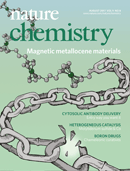 |  Thesis Thesis
 News and Views News and Views
 Correction Correction
 Review Review
 Articles Articles
 Retractions Retractions
 Addendum Addendum
 In Your Element In Your Element |  | Advertisement |  |  |  |  Nature Reviews Materials Nature Reviews Materials
is an online-only, materials science journal that provides an accurate and balanced discussion on a chosen topic, together with an authoritative voice from experienced researchers. Spanning physics, chemistry, biology and engineering, the journal publishes a broad range of Reviews and Comments from world-leading scientists.
EXPLORE THE JOURNAL NOW | |
|
|
 |
|
 |
 |
| Advertisement |
 |
Nature Catalysis is a new online-only journal that will publish work on all areas of catalysis. The journal will provide coverage of the science and business of catalysis research, creating a unique journal for scientists, engineers, and researchers in industry. Nature Catalysis is launching in January 2018 and is now open for submissions.
SUBMIT YOUR RESEARCH TODAY |  | |
 |
| |
Advertisement |
 |
Nature Reviews Chemistry is an online-only journal that provides both an introduction to chemists embarking on a new topic of investigation and thought-provoking, in-depth sections for the expert. The journal also publishes regular columns which focus on the teaching of chemistry and on the translation of research into business opportunities.
EXPLORE THE JOURNAL NOW |  | |
 |
| |
Thesis |  Top Top |
 |
 |
 |
101 libations pp725 - 726
Bruce C. Gibb
doi:10.1038/nchem.2832
Bruce C. Gibb takes a look at the complex cocktail of chemical compounds that make up gin. |
 |
News and Views |  Top Top |
 |
 |
 |
|
 |
Review |  Top Top |
 |
 |
 |
The versatility of boron in biological target engagement pp731 - 742
Diego B. Diaz and Andrei K. Yudin
doi:10.1038/nchem.2814
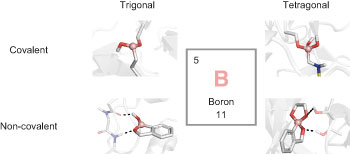
Recent years have witnessed a surge of interest in targeted covalent inhibition of disease-associated proteins. Among the electrophiles used to interact with nucleophilic residues in protein structures, boron is unique for its chameleonic ability to display a range of coordination modes upon interaction with protein targets. |
 |
| Advertisement |
 |
npj Materials Degradation is a new open access journal that is now open for submissions. The journal publishes the finest content describing basic and applied research discoveries in the area of corrosion (degradation) and protection of materials.
Sign up for article e-alerts >> |  | |
 |
| |
Articles |  Top Top |
 |
 |
 |
Main-chain metallopolymers at the static–dynamic boundary based on nickelocene pp743 - 750
Rebecca A. Musgrave, Andrew D. Russell, Dominic W. Hayward, George R. Whittell, Paul G. Lawrence et al.
doi:10.1038/nchem.2743
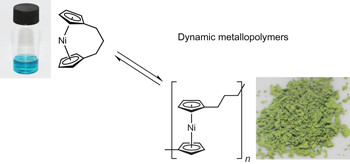
Main-chain polymetallocenes are typically static in nature due to strong metal–ligand bonding. Now, it has been shown that such polymers based on nickelocene are dynamic due to weaker nickel–cyclopentadienyl interactions, and at low concentration or at elevated temperature, depolymerization to the moderately strained monomer occurs.
Chemical compounds |
 |
 |
 |
Cytosolic antibody delivery by lipid-sensitive endosomolytic peptide pp751 - 761
Misao Akishiba, Toshihide Takeuchi, Yoshimasa Kawaguchi, Kentarou Sakamoto, Hao-Hsin Yu et al.
doi:10.1038/nchem.2779
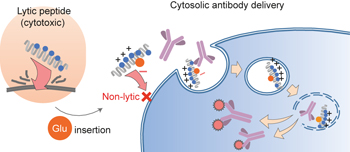
The trapping of antibodies in endosomes often limits their use for intracellular targeting. Now, a single amino acid substitution on a spider-venom peptide has been shown to attenuate the cell membrane lytic activity and enables the selective rupturing of endosomal membranes. The peptide can be used to facilitate the escape of antibodies from endosomes into the cytosol.
See also: News and Views by Sanchez-Navarro et al. |
 |
 |
 |
Cell-permeable nanobodies for targeted immunolabelling and antigen manipulation in living cells pp762 - 771
Henry D. Herce, Dominik Schumacher, Anselm F. L. Schneider, Anne K. Ludwig, Florian A. Mann et al.
doi:10.1038/nchem.2811
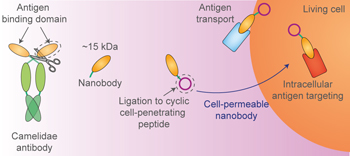
Delivery of antibodies into living cells enables the labelling and manipulation of intracellular antigens; however, transporting antibodies into the cytosol in a functional state is difficult. Now, a modular strategy for creating cell-permeable nanobodies capable of targeting intracellular antigens has been developed. The cell-permeable nanobodies are formed by site-specific attachment of cyclic arginine-rich cell-penetrating peptides to camelid-derived single-chain antibody fragments.
See also: News and Views by Sanchez-Navarro et al. |
 |
 |
 |
Single-molecule spectroscopy of LHCSR1 protein dynamics identifies two distinct states responsible for multi-timescale photosynthetic photoprotection pp772 - 778
Toru Kondo, Alberta Pinnola, Wei Jia Chen, Luca Dall'Osto, Roberto Bassi et al.
doi:10.1038/nchem.2818
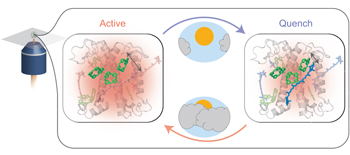
Photoprotection is crucial for the fitness of organisms that carry out oxygenic photosynthesis. LHCSR, a photosynthetic light-harvesting complex, has been implicated in photoprotection in green algae and moss. Now, single-molecule studies of LHCSR have revealed that multi-timescale protein dynamics underlie photoprotective dissipation of excess energy.
See also: News and Views by Walla |
 |
 |
 |
Parameterization of phosphine ligands demonstrates enhancement of nickel catalysis via remote steric effects pp779 - 784
Kevin Wu and Abigail G. Doyle
doi:10.1038/nchem.2741

Ligand development underlies many advances in Pd-catalysed cross coupling but has seen limited application in the growing field of Ni catalysis. Now, a phosphine framework is shown to enable Ni-catalysed Suzuki coupling of acetals. Parameterization studies provide structural insight into ligand success and a quantitative model to facilitate further ligand design.
Chemical compounds |
 |
 |
 |
Scalable and uniform 1D nanoparticles by synchronous polymerization, crystallization and self-assembly pp785 - 792
Charlotte E. Boott, Jessica Gwyther, Robert L. Harniman, Dominic W. Hayward and Ian Manners
doi:10.1038/nchem.2721

A scalable, one-pot, solution-based protocol for the controlled synthesis of uniform non-spherical block copolymer micelles is a desirable but challenging target. Now, a polymerization-induced crystallization-driven self-assembly process has been developed that offers facile access to 1D and platelet micelle morphologies and to near monodisperse cylinders of controlled length. |
 |
 |
 |
Unified biomimetic assembly of voacalgine A and bipleiophylline via divergent oxidative couplings pp793 - 798
David Lachkar, Natacha Denizot, Guillaume Bernadat, Kadiria Ahamada, Mehdi A. Beniddir et al.
doi:10.1038/nchem.2735
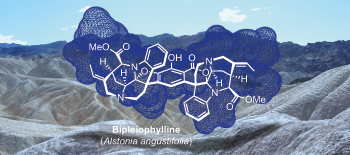
The biomimetic syntheses of bipleiophylline, one of the most complex monoterpene indole alkaloids, and voacalgine A, its biosynthetic precursor, have been achieved from pleiocarpamine starting material. The development of a divergent oxidative coupling for the formation of the benzofuro[2,3-b]indolenine and isochromano[3,4-b]indolenine moieties was key to this accomplishment.
Chemical compounds |
 |
 |
 |
Design of multi-phase dynamic chemical networks pp799 - 804
Chenrui Chen, Junjun Tan, Ming-Chien Hsieh, Ting Pan, Jay T. Goodwin et al.
doi:10.1038/nchem.2737
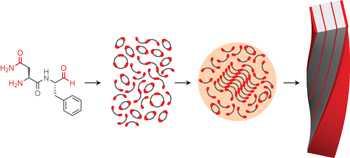
Di- and tripeptide building blocks in which the C-terminus has been converted into an aldehyde are shown to form dynamic chemical networks through imine condensation followed by the formation of cyclic N,N-acetals. The networks exhibit multi-phase growth of prion-like assemblies that template the formation of chain-length-specific peptide-like oligomers.
Chemical compounds
See also: Article by Omosun et al. |
 |
 |
 |
Catalytic diversity in self-propagating peptide assemblies pp805 - 809
Tolulope O. Omosun, Ming-Chien Hsieh, W. Seth Childers, Dibyendu Das, Anil K. Mehta et al.
doi:10.1038/nchem.2738
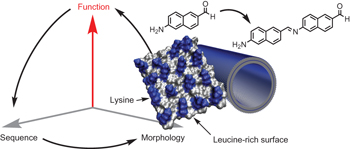
Simple peptides are shown to assemble into well-defined amyloid phases with paracrystalline surfaces that can catalyse reactions in an enantioselective manner. Modifying individual amino acids in the building blocks enables the structure of the assembled aggregates, and the reactions that they can catalyse, to be controlled predictably.
Chemical compounds
See also: Article by Chen et al. |
 |
 |
 |
MoS2 monolayer catalyst doped with isolated Co atoms for the hydrodeoxygenation reaction pp810 - 816
Guoliang Liu, Alex W. Robertson, Molly Meng-Jung Li, Winson C. H. Kuo, Matthew T. Darby et al.
doi:10.1038/nchem.2740
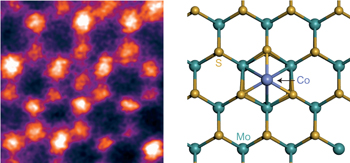
Converting oxygen-rich biomass into fuels requires the removal of oxygen groups through hydrodeoxygenation. MoS2 monolayer sheets decorated with isolated Co atoms bound to sulfur vacancies in the basal plane have now been synthesized that exhibit superior catalytic activity, selectivity and stability for the hydrodeoxygenation of 4-methylphenol to toluene when compared to conventionally prepared materials. |
 |
 |
 |
Macromolecular metamorphosis via stimulus-induced transformations of polymer architecture pp817 - 823
Hao Sun, Christopher P. Kabb, Yuqiong Dai, Megan R. Hill, Ion Ghiviriga et al.
doi:10.1038/nchem.2730

Many properties of polymers are dictated by topology. However, the topology of a macromolecule is typically a static feature after synthesis. Now, an approach to dynamic and transformable macromolecular architecture has been developed. When triggered by an external stimulus, macromolecular topology can be triggered to transform via thermodynamic control. |
 |
 |
 |
A device that operates within a self-assembled 3D DNA crystal pp824 - 827
Yudong Hao, Martin Kristiansen, Ruojie Sha, Jens J. Birktoft, Carina Hernandez et al.
doi:10.1038/nchem.2745
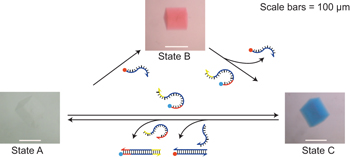
Although DNA nanotechnology has found many applications in developing functional structures, there has never been an independent device contained within a 3D crystal. Now, a self-assembled three-state device that can change the colour of its crystal by diffusion of DNA-ligated dyes has been reported, representing the potential to develop programmable nanomechanical devices. |
 |
| Advertisement |
 |
| |
 |
| |
Addendum |  Top Top |
 |
 |
 |
Addendum: Activating lattice oxygen redox reactions in metal oxides to catalyse oxygen evolution p828
Alexis Grimaud, Oscar Diaz-Morales, Binghong Han, Wesley T. Hong, Yueh-Lin Lee et al.
doi:10.1038/nchem.2819 |
 |
Retractions |  Top Top |
 |
 |
 |
Retraction: Charge transfer to solvent identified using dark channel fluorescence-yield L-edge spectroscopy p828
Emad F. Aziz, M. Hannelore Rittmann-Frank, Kathrin M. Lange, Sebastien Bonhommeau and Majed Chergui
doi:10.1038/nchem.2830 |
 |
 |
 |
 |
Retraction: Transferring electrons to water p828
Anders Nilsson
doi:10.1038/nchem.2831 |
 |
In Your Element |  Top Top |
 |
 |
 |
Meitnerium in tribute p830
Adrian Dingle
doi:10.1038/nchem.2833
Adrian Dingle tells the story of how the name of element 109 represents the lasting recognition that one of the greatest nuclear physicists was in danger of never receiving. |
 |
 Top Top |
 |
 |
 |
| Advertisement |
 |
Nature Briefing
Stay informed with the best science news from Nature and beyond.
Curated by our global news team and delivered direct to your inbox every weekday, free of charge.
Click to learn more |  | |
 |
| |
 |  |  |  |  |  | Natureevents is a fully searchable, multi-disciplinary database designed to maximise exposure for events organisers. The contents of the Natureevents Directory are now live. The digital version is available here.
Find the latest scientific conferences, courses, meetings and symposia on natureevents.com. For event advertising opportunities across the Nature Publishing Group portfolio please contact natureevents@nature.com |  |  |  |  |  |
|
 |


No comments:
Post a Comment